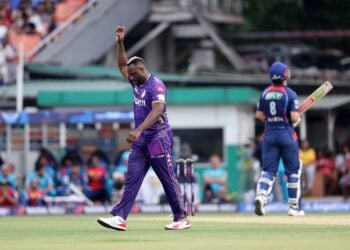The drumbeats of cricket’s most electrifying tournament are growing louder. Official broadcaster JioStar has confirmed that all ten franchises participating in IPL 2026 will announce their retention and release lists on November 15, marking the beginning of another thrilling season of the Indian Premier League. The announcement came shortly after India’s commanding T20I series victory against Australia, instantly sparking conversations across the cricketing universe about which stars will stay and which might seek new horizons.
This confirmation sets the stage for what promises to be a fascinating period of strategic maneuvering, as franchises finalize their squads before heading into the December mini-auction. Unlike previous mega auctions, IPL 2026 brings a revolutionary twist that could fundamentally reshape how teams approach squad building.
Table of Contents
Revolutionary Retention Rules Transform IPL 2026 Strategy
The most significant development for IPL 2026 lies in the unprecedented freedom granted to franchises. For the first time in recent memory, teams face no cap on the number of players they can retain. This groundbreaking policy shift empowers franchises with complete autonomy over their core squad composition, enabling them to preserve established chemistry while maintaining financial flexibility.

This retention flexibility arrives during the second year of the three-year player cycle that commenced with last year’s mega auction. The absence of restrictions means teams can strategically protect their entire core if desired, or selectively release players to create auction room for targeted acquisitions.
IPL 2026 Timeline at a Glance
| Key Date | Event | Significance |
|---|---|---|
| November 15, 2025 | Retention Deadline | All franchises announce retained and released players |
| Early December 2025 | Trade Window Closes | Final opportunity for pre-auction player trades |
| December 13-15, 2025 (Expected) | Mini-Auction | Franchises bid for released and new players |
| January-February 2026 | Pre-Season Preparations | Teams finalize strategies and training camps |
The strategic implications are profound. Franchises that performed strongly in IPL 2025 can maintain continuity by retaining successful combinations, while underperforming teams gain the flexibility to execute surgical changes rather than complete overhauls. This measured approach allows for targeted improvements without destroying established team dynamics.
December Mini-Auction: Where Champions Are Bought
Following the November 15 retention announcements, attention will shift to the mini-auction scheduled between December 13 and 15. Unlike the sprawling mega auctions that reshape entire squads, this focused event allows franchises to address specific gaps and strengthen particular positions. The venue remains under discussion, with Abu Dhabi emerging as the frontrunner, though some reports suggest the BCCI might bring the auction back to Indian soil after consecutive overseas editions in Dubai and Jeddah.
The mini-auction format inherently creates a seller’s market. With fewer premium players available compared to mega auctions, franchises often engage in fierce bidding wars for marquee names. Australian all-rounder Cameron Green stands out as the most sought-after player entering the auction pool. After missing IPL 2025 due to injury, Green’s return has multiple franchises circling, recognizing his dual utility as both explosive batsman and capable bowler.
Top Players Expected in IPL 2026 Auction
| Player Name | Role | Previous Team | Expected Interest Level |
|---|---|---|---|
| Cameron Green | All-rounder | N/A (Injured 2025) | Extremely High |
| KL Rahul | Wicketkeeper-Batsman | Delhi Capitals | High |
| Sanju Samson | Wicketkeeper-Batsman | Rajasthan Royals | High |
| Venkatesh Iyer | All-rounder | Kolkata Knight Riders | Moderate-High |
| Mitchell Starc | Fast Bowler | Chennai Super Kings | Moderate |
| T Natarajan | Fast Bowler | Sunrisers Hyderabad | Moderate |
The auction ecosystem thrives on speculation, and IPL 2026 has already generated significant buzz around potential releases. Venkatesh Iyer, purchased by Kolkata Knight Riders for a staggering ₹23.75 crore in the previous auction, reportedly faces an uncertain future despite the hefty investment. Similarly, Chennai Super Kings may look to offload overseas players like Mitchell Starc and Devon Conway to recalibrate their budget following R Ashwin’s retirement from IPL, which freed up ₹9.75 crore in their purse.
High-Stakes Trade Rumors Dominate Pre-Retention Discussions
The weeks leading up to retention announcements have witnessed intense speculation about potential trades between franchises. The pre-auction trade window remains open until early December, providing teams with opportunities to negotiate player swaps and cash deals before the public auction begins.
Sanju Samson’s future has become the subject of particularly intense scrutiny. The Rajasthan Royals captain and wicketkeeper-batsman has reportedly requested a release, triggering interest from Chennai Super Kings among other franchises. Such high-profile movements demonstrate the evolving nature of player loyalty in franchise cricket, where professional ambitions and team strategies sometimes diverge.

Kolkata Knight Riders have emerged as potential suitors for KL Rahul, viewing him as the perfect captain-wicketkeeper-batsman combination. Rahul, who scored 539 runs in 13 matches for Delhi Capitals after being purchased for ₹14 crore, represents exactly the kind of dual-utility player that teams covet in the modern IPL landscape. Delhi Capitals’ apparent willingness to explore trade discussions adds fuel to the speculation.
Franchise Retention Philosophy Comparison
| Franchise | Expected Strategy | Key Focus Areas |
|---|---|---|
| Chennai Super Kings | Selective releases, core retention | Indian batting depth, pace bowling |
| Kolkata Knight Riders | Strategic additions via trades | Wicketkeeper-batsman, captaincy |
| Rajasthan Royals | Potential captain change | Leadership restructure, spin options |
| Delhi Capitals | Budget rebalancing | Middle-order strengthening |
| Mumbai Indians | Squad optimization | Indian batting, overseas pace |
The trade speculation highlights a broader trend in IPL 2026: the increasing value placed on multi-dimensional Indian players. Franchises have become notably cautious about releasing established domestic stars, particularly those offering dual utility as all-rounders or wicketkeeper-batsmen. This strategic shift recognizes that while overseas superstars provide match-winning moments, Indian core players deliver consistency across entire seasons.
What November 15 Means for IPL 2026 Competition
The retention deadline represents far more than an administrative formality. It serves as the foundational moment when championship contenders are separated from rebuilding projects. Franchises must balance immediate competitive needs against long-term vision, short-term budget constraints against future flexibility, and loyalty to proven performers against the allure of fresh talent.
For defending champions and consistent performers, retention day offers an opportunity to declare continuity and signal stability. These teams typically announce wholesale retention of successful cores, making minimal changes while projecting confidence in their established systems. Conversely, underperforming franchises face the uncomfortable task of identifying which players failed to meet expectations, decisions that inevitably generate controversy among passionate fan bases.
The ripple effects of these decisions extend far beyond individual franchises. Every retained player reduces the talent pool available at auction, potentially inflating prices for the remaining names. Every released star creates a domino effect, as multiple franchises immediately begin strategizing how to incorporate that player into their plans. This interconnected web of decisions and consequences makes retention day one of the most analytically fascinating moments in the IPL calendar.
Fan Excitement Reaches Fever Pitch
Social media platforms have exploded with speculation, analysis, and wishful thinking as November 15 approaches. Fantasy league enthusiasts are already modeling potential squad combinations, attempting to predict which players will wear which colors come IPL 2026. Team loyalists debate whether their beloved franchises should prioritize experience or youth, proven performers or exciting prospects, domestic stability or overseas firepower.
The broadcaster’s confirmation has also triggered renewed interest in IPL 2026 among casual fans who typically tune in closer to the actual tournament. This extended engagement period benefits the league commercially, maintaining visibility during the months between seasons and building anticipation for the action to come.
Cricket analysts have begun publishing detailed breakdowns of each franchise’s potential retention lists, examining salary cap implications, squad balance considerations, and strategic priorities. These expert perspectives fuel further discussion, creating a self-reinforcing cycle of engagement that keeps IPL 2026 firmly in the public consciousness despite the actual matches remaining months away.
Learning from Women’s Premier League Retention
The WPL retention process, which concluded recently, offers valuable insights for understanding how franchises approach these critical decisions. The biggest surprise came when UP Warriorz released Deepti Sharma, demonstrating that even established stars face uncertain futures when franchises prioritize strategic realignment over individual loyalty. This precedent suggests that IPL 2026 retention announcements might similarly contain unexpected releases that challenge conventional wisdom about untouchable players.
The WPL also introduced the Right to Match (RTM) card system for the first time, allowing franchises to reclaim released players during auctions by matching the highest bid. Whether this mechanism will feature in the IPL 2026 mini-auction remains to be seen, but its successful implementation in WPL suggests the BCCI might consider expanding its usage.
The Road Ahead for IPL 2026
November 15 marks just the beginning of a carefully orchestrated sequence of events leading to IPL 2026. Following retention announcements, player registration for the mini-auction will open, allowing released cricketers and new entrants to declare their availability and set base prices. The BCCI will then categorize players into different auction pools, creating the marketplace from which franchises will build their final squads.
Between the retention deadline and the December auction, franchises can still execute trades, providing a final window for negotiated deals before public bidding begins. This period often sees last-minute agreements as teams realize they need specific player types or discover unexpected availability of targeted acquisitions.
Once the auction concludes, franchises will shift focus to pre-season preparations, assembling their finalized squads for training camps and practice matches. The actual IPL 2026 season will likely commence in March or April, following the established calendar that allows for optimal weather conditions and minimal scheduling conflicts with international cricket.
Conclusion: A New Chapter Begins
The confirmation of November 15 as the IPL 2026 retention deadline by broadcaster JioStar signals the official commencement of preparations for the league’s nineteenth edition. With revolutionary retention rules, high-stakes trade negotiations, and the promise of a competitive December mini-auction, the upcoming months will be crucial in determining which franchises emerge as championship contenders.
The absence of retention caps fundamentally alters the strategic landscape, empowering franchises with unprecedented control over squad composition while maintaining the excitement of auction-day uncertainty. As teams finalize their retention lists over the coming days, fans can expect a captivating blend of continuity and change, loyalty and strategic ruthlessness, established stars and emerging talents.

IPL 2026 promises to deliver the same explosive cricket that has made the tournament a global phenomenon, but the journey to those thrilling matches begins with the crucial decisions franchises will unveil on November 15. The countdown has officially begun.
Read More: Women’s World Cup 2025: India’s Victory Draws 185 Million Viewers, Matches Men’s T20 Final Record
FAQs
When will IPL 2026 retention lists be announced?
All ten IPL franchises will announce their retention and release lists on November 15, 2025, as confirmed by official broadcaster JioStar. This date marks the deadline by which teams must finalize which players they’re keeping and which will enter the mini-auction pool.
Is there a limit on how many players teams can retain for IPL 2026?
No, IPL 2026 features no cap on the number of players franchises can retain. This unprecedented flexibility allows teams to keep their entire squad if desired, or selectively release players to create auction opportunities. This contrasts sharply with retention rules preceding mega auctions, which typically impose strict numerical limits.
When and where will the IPL 2026 mini-auction take place?
The IPL 2026 mini-auction is expected to occur between December 13-15, 2025, though the BCCI has not officially confirmed exact dates. The venue remains under discussion, with Abu Dhabi emerging as the leading candidate, though some reports suggest the auction might return to India after consecutive overseas editions.
Which major players might be released before IPL 2026?
Speculation surrounds several high-profile players potentially entering the auction. Cameron Green tops the list of available talent after missing IPL 2025 due to injury. Other names generating discussion include KL Rahul (Delhi Capitals), Sanju Samson (Rajasthan Royals), Venkatesh Iyer (Kolkata Knight Riders), Mitchell Starc (Chennai Super Kings), and T Natarajan (Sunrisers Hyderabad), though no releases have been officially confirmed.
How does the IPL 2026 mini-auction differ from a mega auction?
Mini-auctions feature significantly smaller player pools compared to mega auctions, where franchises rebuild squads almost entirely from scratch. IPL 2026’s mini-auction focuses on surgical improvements rather than wholesale changes, as it occurs during the second year of the current three-year player cycle. Teams can retain most of their existing players while targeting specific positions that need strengthening, creating a more competitive bidding environment for the limited premium talent available.








